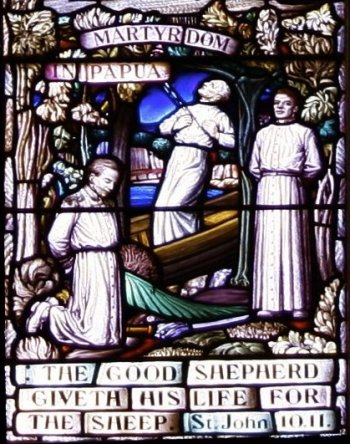
The caption for the bottom panel of the central light reads "Martyrdom in Papua"; and the inscription at the bottom is taken from the Gospel of St John, 10.11: "The good shepherd giveth his life for the sheep." In 1946 only three priests from the New Guinea Missions were recognized among the list of Anglican Martyrs: Henry Holland, Vivian Redlich, and Henry Matthews. This panel is a reasonably graphic representation of the martydom of these three: the priests in the foreground on either side are bound, with a naked sword lying on the ground between them—linking this scene to the beheading of Frs Holland and Redlich on Buna Beach. The figure in the centre, on the other hand, is standing in a boat, staggering from a blow from afar, and a red spurt of blood comes from his left side. This clearly represents the death of Fr Matthews, who was killed when the boat in which he was taking refugees to safety at Daru was shot up and sunk by a Japanese submarine.
This second scene of martydom takes up again the theme of Goodness, seen so arrestingly in sacrifice and suffering: "the shepherd giving his life for the sheep." The sacrifice is not unredeemed, however, because next to the sword on the beach we can see a vivid green palm frond of victory.
Just as we can discern a focus on the role of women in the Missions in the left light, the focus in this central light is on the Church—all the prominent figures are clerical, bishops and priests, and hence (necessarily at that time), all male. Although the work in schools and hospitals was important to the Mission, the priestly function was the centre from which all else flowed. As Fr Maynard puts it in his sermon notes: "Goodness:– truth and beauty translated into action."